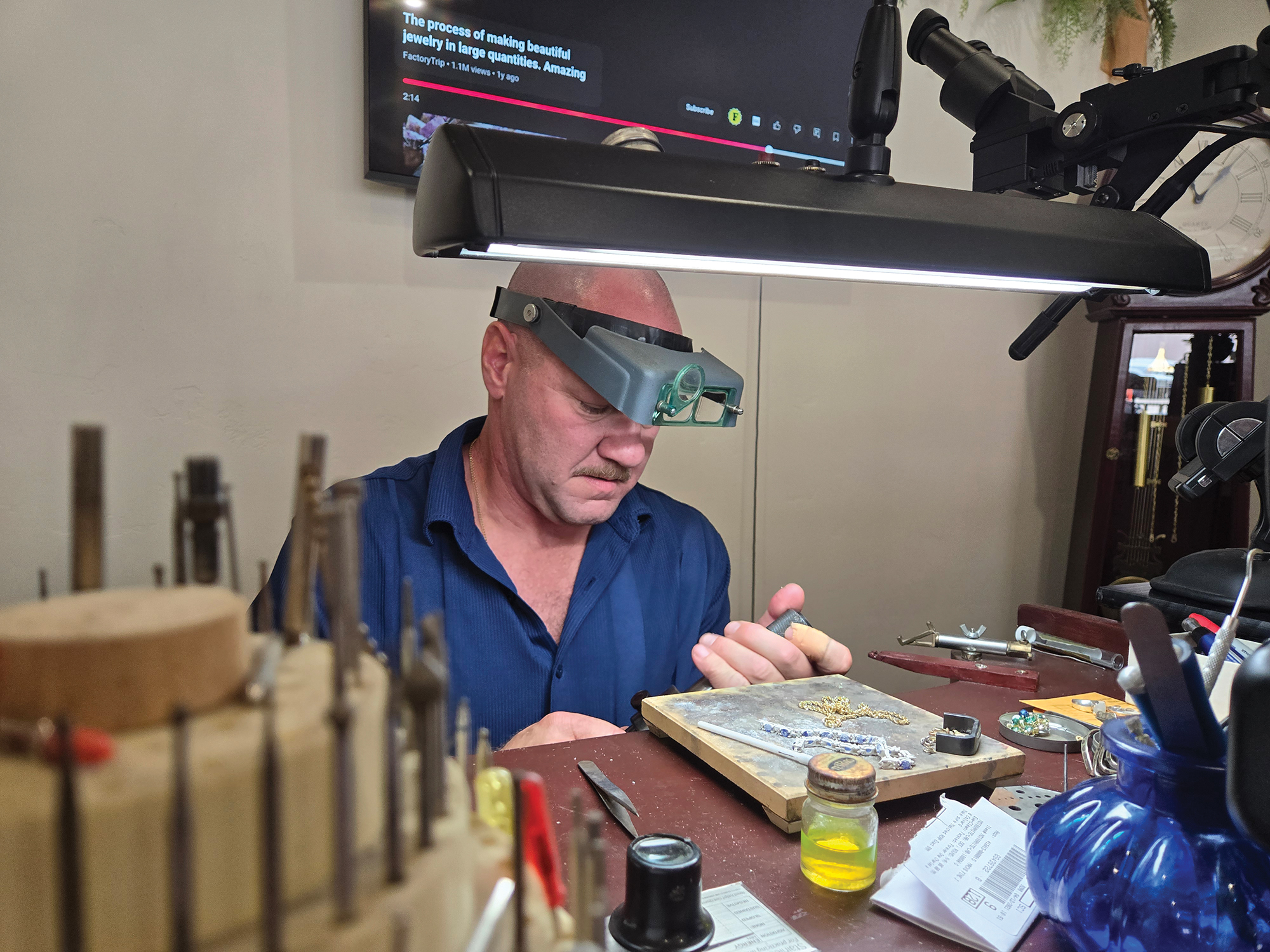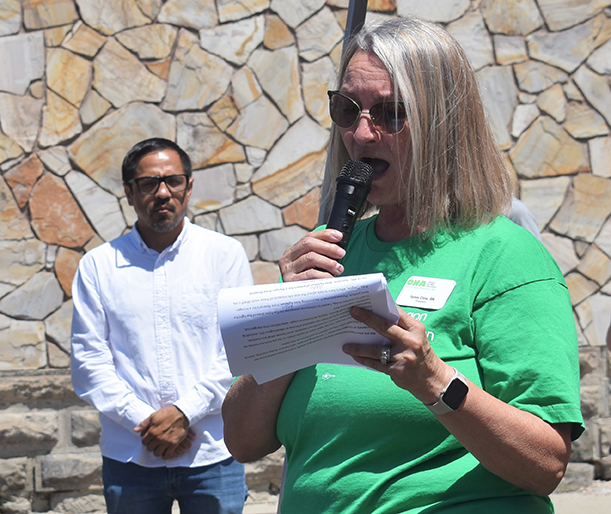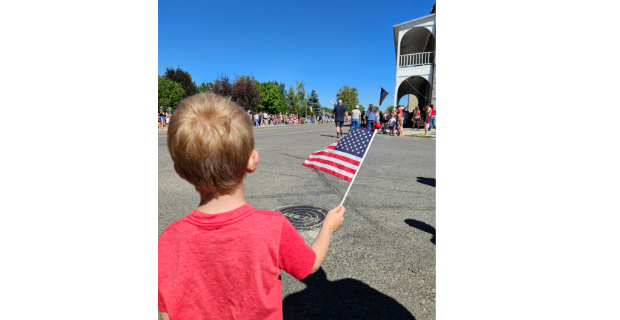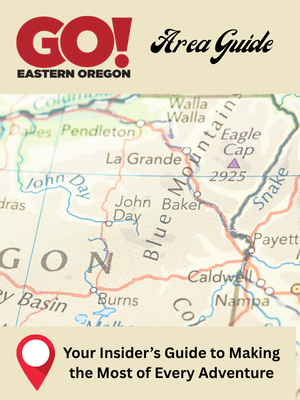Wilderness family: Baker City
Published 5:17 pm Friday, September 9, 2011
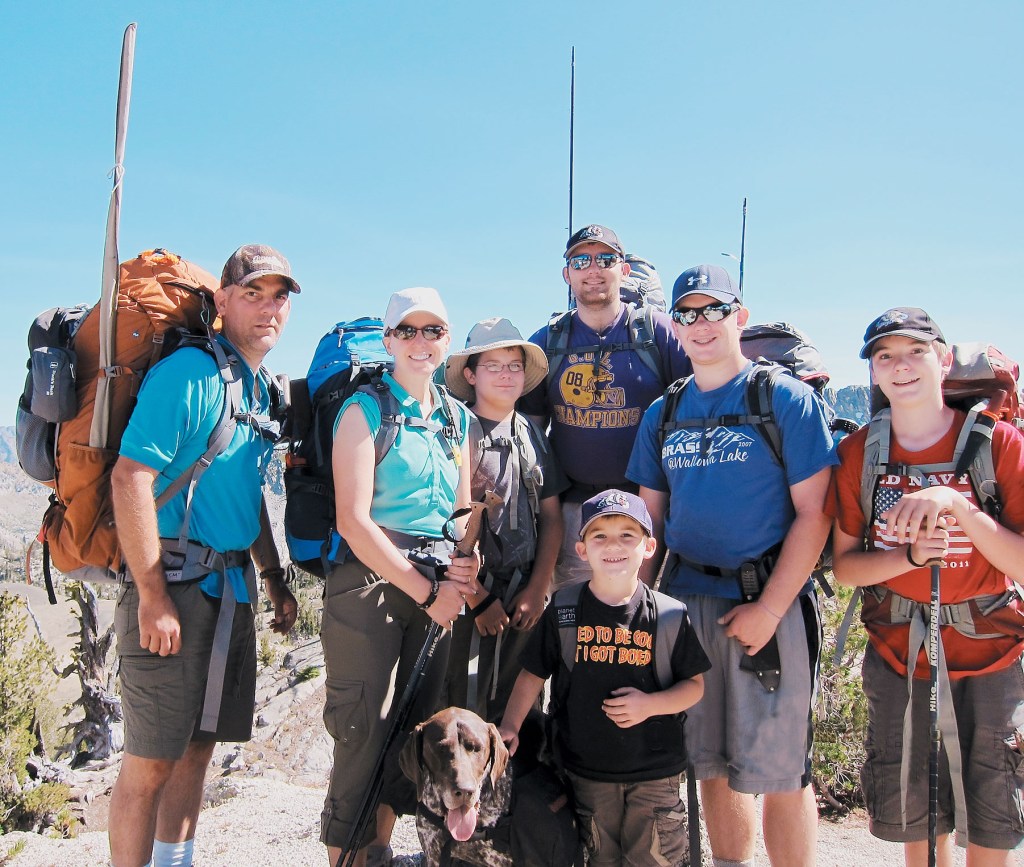
- The Smithson family from Baker City at a pass in the Eagle Cap Wilderness. The whole family went on a three-night, four-day backpacking trip during Labor Day Weekend. Kneeling in front, with Hunter the dog, is Thomas, 6, the youngest of the five Smithson boys. From left to right: Dan, his wife, Elizabeth, Brady, 11, James, 19, Timothy, 17, and Scott, 13.
By JAYSON JACOBY
jjacoby@bakercityherald.com
Elizabeth Smithson is that rare mother whose treasured family memories involve an avalanche.
And a boulder-strewn scramble disguised as a hike.
Also tears shed over a lost dog.
This is not as strange as it sounds.
Not after you’ve listened to Elizabeth explain how a backpacking trip in the Eagle Cap Wilderness this Labor Day weekend tightened the bond between she and her husband, Dan, and their five sons.
Then you’ll understand.
You’ll understand even if you’ve never donned a pair of high-ankled
boots or pitched a tent in a mountain glen or cooked supper over a
small, bright fire of subalpine fir.
You’ll understand because you can’t miss the sheen in Elizabeth’s eyes
as she looks at the photograph on her computer monitor, her sons
grinning over some little joke one of them has just told.
It’s the scene that matters, not the setting.
The Smithsons could be at a ballgame or the beach or in their own backyard.
“As parents, as we watched our boys playing together, laughing
together, we were saying to each other how great it is that our boys
are seeming almost to reconnect,” she says. “This kind of trip is so
important to our family. No electronics allowed. The kids actually have
to talk to each other.”
Before the laughter and the camaraderie, though, there is the challenge of the bags.
Dozens of bags.
Each waiting to be filled, organized, crammed into a pack.
You don’t just drive to the trailhead and start walking.
Well, you could.
But you shouldn’t.
Elizabeth is clear on this point.
Although with five boys to accommodate, spanning the age range from 6
to 19 and with an equally wide spectrum of appetites and attitudes and
abilities, her dilemma is rather more ticklish than is typical.
“There’s a lot of planning,” Elizabeth says.
Fortunately, she and her husband don’t merely tolerate that aspect of their excursions.
They like it.
“I think preparing for the trip is about as fun as taking the trip
itself,” Elizabeth says. “My husband spends weeks researching routes.
It makes for a better trip.”
Certainly it makes for a neater trip.
Which is where that assemblage of bags enters the proceedings.
Elizabeth is especially enamored with plastic ones, the kind you seal by pressing two flexible strips together.
She employs the whole galaxy of sizes.
Tiny ones to store spices that add zing to healthy but bland meals featuring brown rice or quinoa.
Larger bags to hold trail mix and carrots and pancake mix and all the
other food necessary to sustain a family of 7 through four days and 17?
miles, none of them paved.
Or flat.
Dan’s weakness are an assortment of nylon bags – cunning little
containers with zippers and straps and mesh pockets that are suitable
for keeping organized just about anything you can’t eat.
The Smithsons, for instance, have one bag just for headlamps and flashlights.
Every family member has two bags for clothes.
“Every time we go to REI or Cabela’s he just loves to look at all the little bags,” Elizabeth says of her husband.
Being organized helps prevent the sorts of minor annoyances that can mar an otherwise fun trip, she says.
Running out of food eight miles back in the wilderness, for example.
To avoid such unpleasantness, Elizabeth plans each meal for the entire trip, labeling the appropriate bags with a felt pen.
On Sept. 1, the day before the Smithsons left for their holiday weekend
journey, she spent 12 hours assembling the food, a task that included
shopping, preparing and packing.
Elizabeth, as you might expect, writes a lot of lists.
Food, though a nice thing to have when you’re 25 miles from the nearest restaurant or market, isn’t the only necessity.
It’s not even the most important.
Not when you’re bringing a 6-year-old on his first extended backpacking trip, anyway.
Here, too, preparation is vital.
Elizabeth says the couple’s youngest son, Thomas, has joined the family on day hikes since he was 4.
Elizabeth, 40, and Dan, 44, introduced Thomas to hiking the same way
they did their older boys: James, 19; Timothy, 17; Scott, 13; and
Brady, 11.
“At first you go a mile or two and you go super slow and you make it
fun and exciting,” Elizabeth says. “You don’t start with 17 miles.”
Not unless you fancy carrying a 6-year-old piggy back for several miles.
It seems inevitable that backpacking would become one of the Smithsons’ favorite pastimes.
“Dan and I love to hike,” Elizabeth says. “By the time James was a year
old he’d probably slept in a sleeping bag as often as in his own bed.”
When the Smithsons moved to Baker City 11 years ago from Colorado,
where Dan, who is a doctor, was in residency, they drove here from
Boise.
For the first 115 miles or so of the 125-mile drive, the couple were, well, disappointed.
“We were thinking, ‘this is nothing like Colorado,’ ” Elizabeth says.
“Then, finally, we came around that corner and saw the Elkhorns
Mountains and we said ‘OK, this is all right.’ “
Last summer the Smithsons, as a family, hiked about four miles up the
Main Eagle trail from Boulder Park. They camped at Eagle Meadows and
from there took short day hikes during the weekend.
This year the couple figured Thomas, who turned 6 in August, was ready for a more ambitious excursion.
After poring over topographic maps and consulting guidebooks, Dan
plotted two possibilities, both starting again at Boulder Park.
One route, covering about 19 miles, went by Echo and Traverse lakes and ended at West Eagle Meadows.
The trip the Smithsons ended up choosing was slightly shorter, at 17?
miles, and it had the advantage of ending where it started.
Its disadvantage was the avalanche.
More specifically, the mess the avalanche left in its path.
After camping the first night in Eagle Meadows, the Smithsons hiked up the Eagle Creek Canyon toward Cached Lake.
Before they got there they came across a jumble of snapped off trees,
boulders and other avalanche debris that very nearly obliterated a
section of the trail.
“It was nasty,” says James.
The family got through that obstacle course and camped the second night at Cached Lake.
They faced their second challenge the next day.
After climbing to the pass between Eagle and Trail creeks, the
Smithsons decided to take a cross-country route across the generally
open terrain rather than follow the trail, which switchbacks down for a
mile or so, then regains most of that elevation climbing to a pass near
Arrow Lake.
As is common with short cuts, this one really wasn’t.
The gentle slope turned into a much steeper, and rockier, descent.
Not a cliff, certainly.
But not a trail, either.
“Fun,” is how Scott Smithson, 13, describes this detour.
His mom wouldn’t choose that adjective.
Yet those two stretches of hard hiking created memories that she will cherish always.
“Just working together as a family to get past those obstacles,”
Elizabeth says. “Timothy took Thomas’ hand (on the steep, off-trail
descent) and he was just so sweet with him, so protective.”
That evening, around a campfire at Heart Lake, Dan Smithson used their
adventure as a metaphor, a sort of life lesson for his sons.
“He talked about how the route that might seem easier or more fun or
more adventurous sometimes is not the right way to go,” Elizabeth says.
“It was a good lesson about staying on the path.”
The Smithsons’ German shorthair, Hunter, meanwhile followed an altogether different path.
A much longer one.
When the Smithsons arrived at Heart Lake for their final night’s camp, they met a family from Union and got to talking.
The Union family was heading in the opposite direction, toward Cached Lake.
After the families said good-bye, the Smithsons noticed that Hunter wasn’t around.
Dusk fell and still he didn’t come into camp.
The next morning, Labor Day, their hike out to the trailhead was a sad one.
They thought they had lost Hunter.
“My kids were in tears,” Elizabeth says.
Yet when they walked up to their car they were shocked, and overjoyed,
to see the dog. Hunter was tied to a tree, a pan of water nearby.
A handwritten note stuck on the car told the tale – part of it, anyway.
The man who left the note had found Hunter about 7 p.m. Sunday on the pass where the Smithsons started their detour.
Elizabeth speculates that Hunter got confused and at least for a while
followed the family from Union. Then, perhaps, he picked up the
Smithsons’ scent and followed it back to the pass.
In any case, the hiker who found Hunter led him back to Boulder Park on Labor Day, arriving about 11 a.m.
There the dog recognized the Smithsons’ car and started barking.
The hiker tied Hunter to the tree and filled a dish with water.
The hiker included his name and phone number on the note, Elizabeth says, but she hasn’t been able to reach him.
Elizabeth understands that the prospect of spending several days in the
wilderness, with the kids along, might intimidate some parents.
Or seem downright foolish to others.
It needn’t be, she insists.
“There’s no reason in the world why anybody couldn’t do this,” she
says. “If you’re not experienced, talk to other people who are. We
would love to take a family who hasn’t done it before.”
Elizabeth says the Smithsons have relied on local experts to help plan their trips in the Eagle Cap.
One expert in particular.
“Farel Baxter, whose father built a lot of the trails up there, has
been an incredibly valuable resource for us,” Elizabeth says. “He knows
that country like the back of his hand.”
In choosing a route the key, she says, is to make sure the family’s goals reflect the abilities of its youngest member.
In the Smithsons’ case, that’s Thomas.
“What we did is focus on enjoying the journey,” Elizabeth says. “We stayed at his pace.”
Again, preparation is crucial – except this particular process takes years, not hours.
The Smithsons, because they had ushered Thomas into hiking gradually
rather than expecting, unreasonably, that he would keep up with his
teenage brothers the first time out, knew what he was capable of.
And they rewarded his efforts with treats.
Simple things, like taking frequent rest breaks to drink water or eat a granola bar or share a handful of Jolly Ranchers.
(The Smithsons call the little rectangular confections “fishing candy,”
a longtime family tradition that dates to the boys’ paternal grandpa,
whose name was Brady but who they called Peachy. Grandpa, who died more
than a decade ago, always carried a few of the sweets in his pocket.)
“You have to realize how much energy kids are expending – more than
adults,” Elizabeth says. “They’re so little, and you need to let them
refuel.”
The Smithsons emphasize healthy fuel, too, when amassing their food for a long hike.
Combining nutritious food with exercise is ideal, Elizabeth says.
“We’ve always been very health conscious,” she says. “We try to teach our kids young how beneficial it is to stay active.”
Thomas Smithson turned out to be a strong hiker.
“He was keeping up with us,” said his oldest brother, James, 19. “Even
if he was taking three steps for every one of mine. It was kind of
funny, actually.”
For their mom, the trip was quite a lot more than that.
As she scrolls through the dozens of photographs from the trip, each scene spurs a memory.
Thomas and his dad, sitting beside the path and sharing a bag of trail mix, both with wide smiles.
The four older boys ensconced in their tent on a morning when frost lay
on the nylon walls like fine dust, little showing outside their
sleeping bags except tendrils of mussed hair.
Thomas perched on a chunk of granite that juts from Cached Lake, reeling in his very first trout.
It’s clear that these memories, this accumulation of visual anecdotes that comprise a family’s identity, will persist.
It’s easy to imagine Smithsons smiling again at these images decades
from now, with grandkids there to absorb and preserve this history,
much as five boys have kept alive Peachy and his fishing candy.
This is why the weeks of preparation are no burden.
Why Elizabeth doesn’t begrudge all those bags, and why Dan squints to make out those squiggly contour lines on wilderness maps.
“We call them our family weekends,” Elizabeth says, “and they’re sacred.”
And for just that instant, her smile is replaced by a look that’s both serious and infinitely more powerful.
Love.


